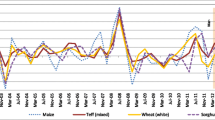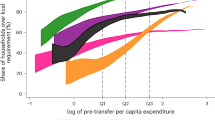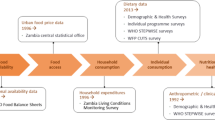Abstract
This paper investigates the influences of food price spikes on nutritional outcomes in six African countries: DR Congo, Ethiopia, Malawi, Nigeria, Tanzania, and Uganda. Drawing on the estimates of food demand elasticity with respect to food prices in previous studies, we constructed the elasticity of calorie and protein consumption with respect to food prices. We find that, while increasing cereal prices has the largest negative influences on both calorie and protein consumption in all the countries, the magnitude of the influences may differ by regions and the country’s dietary patterns. The negative influences are particularly large in rural areas and in the countries whose diets highly depend on a single staple cereal while small in the countries whose diets have alternative staple foods. Our findings highlight the importance of stabilizing cereal prices to reduce calorie deficiency while it may not be enough to improve protein deficiency.


Similar content being viewed by others
Notes
Because Ecker and Qaim (2011) estimated both food demand and the corresponding nutrition elasticities for Malawi, we do not need to construct nutrient elasticities here.
The positive effect is due to the combination of a relatively small decline in maize consumption and a large substitution with sugar consumption.
References
Abudular, A., & Aubert, D. (2004). A cross-section analysis of household demand for food and nutrients in Tanzania. Agricultural Economics, 31(1), 67–79.
Behrman, J. R., & Deolalikar, A. B. (1987). Will developing country nutrition improve with income-a case study for rural south India. The Journal of Political Economy, 95(3), 492–507.
Boysen, O. (2012) A Food Demand System Estimation for Uganda. IIIS Discussion Paper No. 396.
Ecker, O., & Qaim, M. (2011). Analyzing Nutritional Impacts of Policies: An Empirical Study for Malawi. World Development., 39(3), 412–428.
Elijah, O. A., Okoruwa, V. O., & Ajani, O. I. Y. (2009). Cross-sectional analysis of food demand in the North Central, Nigeria: The quadratic almost ideal demand system (QUAIDS) approach. China Agricultural Economic Review, 1(2), 173–193.
FAO (2008) Soaring food prices: facts, perspectives, impacts and actions required. Paper presented at High-level Conference on World Food Security: The Challenges of Climate Change and Bioenergy, Food and Agriculture Organization, Rome, 3–5 June.
FAO (2013) The state of food insecurity in the world 2013. The multiple dimensions of food security. Rome, FAO2013: The Food and Agriculture Organization of the United Nations, Rome.
Fashogbon, A. E., & Oni, O. A. (2013). Heterogeneity in Rural Household Food Demand and Its Determinants in Ondo State, Nigeria: An Application of Quadratic Almost Ideal Demand System. Journal of Agricultural Science, 5(2).
Ferreira, F. H. G., Fruttero, A., Leite, P. G., & Lucchetti, L. R. (2013). Rising Food Prices and Household Welfare: Evidence from Brazil in 2008. Journal of Agricultural Economics, 64(1), 151–176.
Friedman, J., & Levinsohn, J. (2002). The distributional impacts of Indonesia’s financial crisis on household welfare: A ‘rapid response’ methodology. World Bank Economic Review, 16(3), 397–423.
Huang, K. (1996). Nutrient elasticities in a complete food demand system. American Journal of Agricultural Economics, 78(1), 21–29.
Leyaro, V., Morrissey, O., & Owens, T. (2010) Food price changes and consumer welfare in Tanzania 1991–2007. CREDIT Research Paper, NO. 10/01.
Mafuru, J. & Marsh, T. L. (2003) An Analysis of Household Food Expenditure Systems in Tanzania. Selected Paper prepared for presentation at the Western Agricultural Economics Association Conference, The Denver Adam’s Mark Hotel, July 12–15, 2003.
Ogundari, K., & Abdulai, A. (2013). Examining the heterogeneity in calorie–income elasticities: A meta-analysis. Food Policy, 40(1), 119–128.
Shimokawa, S. (2010). Asymmetric intra-household allocation of calories in China. American Journal of Agricultural Economics., 92(3), 873–888.
Tafere, K. et al. (2010) Food Demand Elasticities in Ethiopia: Estimates Using Household Income Consumption Expenditure (HICE) Survey Data. ESSP2 Discussion Paper 011. IFPRI.
Tefera, N., Demeke, M., & Rashid, S. (2012) Welfare Impacts of Rising Food Prices in Rural Ethiopia: a Quadratic Almost Ideal Demand System Approach. Selected Paper prepared for presentation at the International Association of Agricultural Economists (IAAE) Triennial Conference, Foz do Iguaçu, Brazil, 18–24 August, 2012.
Tian, X., & Yu, X. (2013). The Demand for Nutrients in China. Frontiers of Economics in China., 8(2), 186–206.
Ulimwengu J., Roberts, C., & Randriamamonjy, J. (2012) Resource-rich yet malnourished: analysis of the demand for food nutrients in the Democratic Republic of Congo. IFPRI Discussion Paper 01154, January 2012
von Braun, J. & Díaz-Bonilla, E. (2008) Globalization of food and agriculture and the poor. IFPRI Issue Brief 52 • September 2008. Available at http://ebrary.ifpri.org/utils/getfile/collection/p15738coll2/id/127382/filename/127593.pdf.
World Bank (2016) World Development Indicators. Accessed on 5 April 2016.
Yu, X. (2014). Raising food prices and welfare change: a simple calibration. Applied Economics Letters, 21(9), 643–645.
Zhou, D., & Yu, X. (2016). Calorie elasticities with income dynamics: evidence from the literature. Applied Economic Perspective and Policy, 38(1), 50–72.
Author information
Authors and Affiliations
Corresponding author
Rights and permissions
About this article
Cite this article
Yu, X., Shimokawa, S. Nutritional impacts of rising food prices in African countries: a review. Food Sec. 8, 985–997 (2016). https://doi.org/10.1007/s12571-016-0605-7
Received:
Accepted:
Published:
Issue Date:
DOI: https://doi.org/10.1007/s12571-016-0605-7




